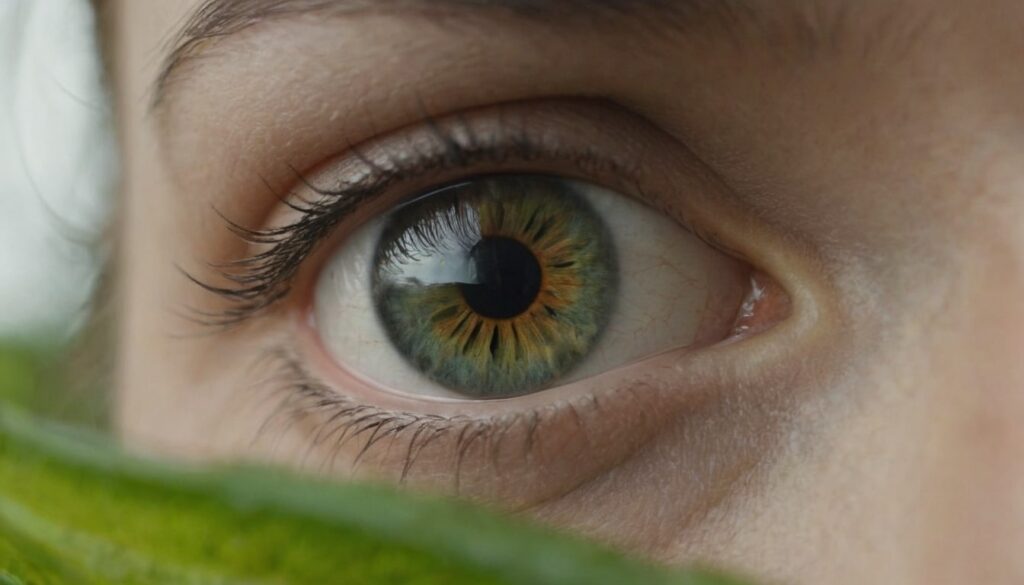Unique Eye
Ihr Leitfaden, Informationen und Tipps
Introduction: The Allure of Unique Eye Colors

Key Takeaways: Unraveling the Mystique of Unique Eye Colors
| Eye Color | U.S. Population | World Population |
|---|---|---|
| Gray and other | Less than 1% | Less than 1% |
| Green | 9% | 2% |
| Hazel/amber | 18% | 10% |
| Blue | 27% | 8% to 10% |
| Brown | 45% | 55% to 79% |
| Key Takeaway | Description |
|---|---|
| Eye Color Diversity | Explores the wide range of unique eye colors beyond common perceptions, highlighting the beauty and rarity of certain hues. |
| Genetic and Environmental Influences | Discusses how genetics and environment interact to determine eye color, offering insight into the complexity of human traits. |
| The Rarity of Certain Hues | Delves into the rarest eye colors, such as amber and gray, explaining their genetic origins and rarity in the population. |
| The Science of Eye Color | Unveils the biological and genetic mechanisms behind eye color variation, emphasizing the role of melanin and genetic mutations. |
| Human Diversity and Identity | Celebrates the diversity of eye colors as a reflection of the broad spectrum of human genetics, contributing to individual uniqueness. |
| Evolutionary Perspectives | Offers an evolutionary view on why certain eye colors have emerged and persisted across different human populations. |
| Appreciating Unique Beauty | Encourages an appreciation for the uniqueness and diversity of eye colors, recognizing them as part of the rich tapestry of human appearance. |
Very unique eye colors at first!
Understanding Heterochromia: The Beauty of Unique Eye Colors
The Science Behind Anisocoria and Its Connection to Eye Color Variations
The Science of Sunlight and Brown Eyes
Behind Blue Eyes: Rarity or Widespread?
The intrigue surrounding blue eyes centers on their genetic origins and geographical distribution. Contrary to the notion of rarity, blue eyes are relatively common in certain parts of the world, thanks to a genetic mutation affecting the OCA2 gene on chromosome 15. This mutation reduces the production of melanin in the iris, resulting in the blue appearance. Originating around 6,000 to 10,000 years ago, this genetic change has proliferated, especially among populations in Northern Europe, where it is seen as a defining characteristic.
Geographically, the prevalence of blue eyes varies, being most common in Northern and Eastern Europe, while rare in regions where darker traits dominate. This distribution reflects a fascinating aspect of human evolution, where genetic mutations can spread and become prominent features within isolated populations. Blue eyes serve as a testament to the complexity of genetic inheritance and the diverse tapestry of human phenotypes.
Rare, Rarer – Green
Green eyes, a symbol of rarity and allure, captivate with their unique beauty, representing a sliver of the global population. This unique eye color results from a subtle interplay of melanin and the Rayleigh scattering effect, which also paints the sky blue. The genetic dance behind green eyes involves a specific amount of melanin and the scattering of light, a combination less common than the more prevalent blue or brown eyes, making them a rare genetic marvel.
Found most frequently in European populations, particularly those with Celtic or Germanic heritage, green eyes are a testament to the diversity within human genetics. They highlight how variations in genetic codes can lead to a wide array of physical traits, including the captivating hues of unique eye colors. As researchers delve deeper into the study of genetics, green eyes remain a fascinating focus, emblematic of the intricate and beautiful diversity of the human race.
The most unique Eye Color: Amber?
Amber eyes, often described as a golden, coppery hue akin to that of liquid honey, stand out for their rarity and beauty. This unique eye color is due to a specific combination of the yellow and copper pigments in the iris, with a relatively low level of melanin compared to brown eyes. Unlike blue or green eyes, which result from the scattering of light, amber eyes get their striking appearance from the dominance of the pigment lipochrome within the iris.
The genetic basis for amber eyes is less understood than that of blue or green eyes, making them a subject of curiosity and fascination. They are most commonly found in regions such as South America and Asia, but even there, they remain a rare sight. Amber eyes not only captivate with their beauty but also add to the rich tapestry of human diversity, reminding us of the genetic complexity that underlies each individual’s unique appearance.
Tipp: Look into our Natural Eye Color Chart.
The Enigma of Gray Eyes
Gray eyes, a hue that captures the mystique of the human eye color spectrum, are another rarity that intrigues with its subtle beauty. This unique eye color is characterized by a low amount of melanin and a different composition that scatters light differently than blue eyes, giving them their distinct silvery-gray appearance. Unlike the more saturated colors, gray eyes often change shades based on the lighting conditions, adding to their enigmatic quality.
The genetics behind gray eyes are complex and not as well-documented as those for blue or green eyes, making them a fascinating area for genetic research. While more common in Eastern European countries, they are still considered rare globally. Gray eyes exemplify the incredible variety of human eye colors, demonstrating how minor variations in genetics and melanin can result in a wide array of beautiful and unique eye colors.

Back
Greyblue
Ravi
Sapphire Blue
„Unveiling the Spectrum: From the Golden Hues of Amber to the Mystical Shades of Gray, Explore the Rare Gems of the Human Eye Color Palette.“
Red Eyes: Myth or Reality?
Red eyes, often shrouded in myth, are a reality for a select few, primarily resulting from a condition known as albinism. This unique eye color occurs due to the absence or severe reduction of melanin, the pigment responsible for coloring our eyes, skin, and hair. In individuals with albinism, the lack of melanin allows the blood vessels within the eye to show through, giving the iris a reddish appearance. This phenomenon is rare and highlights the significant impact of genetics on eye color.
The presence of red eyes in humans challenges common perceptions of eye color possibilities, expanding the spectrum into the extraordinary. While often misunderstood, red eyes offer a vivid reminder of the genetic diversity within the human population, emphasizing the beauty in uniqueness. As we explore the genetics of eye color, red eyes serve as a testament to the wide range of human traits shaped by our genetic makeup.
Can You Change Your Eye Color?
The possibility of changing one’s eye color has moved from the realm of fantasy to a tangible reality, thanks to advances in medical science. While traditionally eye color is determined by genetics and considered permanent, technological innovations have introduced procedures that can alter this inherent trait. Laser surgery and iris implantation are two such methods that promise a change in eye color, targeting those seeking to transform their looks for cosmetic reasons.
However, these procedures come with significant risks and ethical considerations. Altering eye color through surgery can lead to complications, including vision loss, inflammation, and the risk of irreversible damage. The debate around these practices centers on the balance between personal autonomy in cosmetic enhancement and the potential health repercussions. As the fascination with unique eye colors continues, the prospect of changing them artificially prompts a deeper discussion on the value we place on natural beauty versus the desire for customization.
What Your Eye Color Says About You
The lore surrounding eye color and personality traits is a tapestry of folklore and curiosity, weaving together tales that suggest our eyes are more than just windows to the soul; they might also hint at deeper aspects of our personalities. While science has yet to find concrete links between eye color and personality, the myths persist, captivating our imaginations. For instance, brown eyes are often associated with strength and reliability, blue eyes with sensitivity and kindness, green eyes with mystery and intelligence, and gray eyes with balance and self-sufficiency.
Despite the lack of scientific evidence, these associations play a significant role in cultural narratives and personal identities, illustrating how human nature seeks to find meaning and connection in physical traits. The fascination with what eye color might reveal about a person’s character highlights our ongoing quest to understand ourselves and each other better. While your eye color might not dictate your personality, it certainly adds to the unique story each of us tells through our appearance.
In the end: A Celebration of Unique Eye Colors
In our journey through the captivating world of unique eye colors, we’ve unveiled the science, myths, and marvels behind the hues that make each gaze distinct. From the rare golden amber to the mystical gray, and the reality of red eyes in albinism, to the potential of changing one’s eye color through modern procedures, we’ve explored the breadth of human diversity as reflected in our eyes. This exploration reminds us that our eye colors are more than just genetic traits; they are part of the rich tapestry that defines human beauty and diversity.
The myths surrounding eye color and personality, though scientifically unfounded, highlight our innate desire to connect and find meaning in the physical attributes that make us unique. As we close this chapter, it’s clear that the true allure of unique eye colors lies not just in their rarity or the stories they might tell about us but in their ability to illustrate the complexity of genetics and the beauty of human variation.
In celebrating unique eye colors, we celebrate ourselves—each individual, a unique blend of traits, contributing to the mosaic of humanity. Let’s continue to appreciate and explore the wonders of genetics, the stories behind our appearances, and the diversity that unites us in our shared human experience.
FAQs
What genetic factors determine eye color?
Eye color is primarily determined by the type and amount of melanin in the iris, influenced by various genes. The most well-known genes involved in eye color determination are OCA2 and HERC2, located on chromosome 15. OCA2 plays a significant role in melanin production, while HERC2 influences OCA2’s expression. Variations in these genes can lead to different eye colors, ranging from very light (blue) to very dark (brown). Additionally, other genes like SLC24A4 and TYR also contribute to the complexity of eye color, affecting shades and variations within individual colors. This genetic interplay results in the wide spectrum of eye colors observed in the human population.
Can environmental influences change eye color?
While genetics primarily determine eye color, environmental factors can influence the perception and, to a lesser extent, the actual coloration of the eyes over time. Sun exposure can increase melanin production, potentially darkening eye color slightly in some individuals. However, significant changes in eye color due to environmental factors are rare after early childhood, when eye color can still be developing and stabilizing. Factors like aging and certain medications can also affect eye color by altering melanin levels or distribution within the iris.
Are green eyes really the rarest?
Green eyes are among the rarest eye colors worldwide, but they are not the absolute rarest; that title often goes to amber or gray eyes depending on the population being studied. Approximately 2% of the world’s population has green eyes, with the highest concentration found in Northern, Central, and Eastern European countries. The rarity of green eyes is due to the specific genetic requirements needed for their development, including the low to moderate presence of melanin and the way light scatters in the iris.
Are there any health risks associated with different eye colors?
Generally, eye color itself does not directly result in health risks. However, individuals with lighter eye colors, such as blue or green, may be more susceptible to certain conditions due to the lower levels of melanin in their eyes. For example, they might have a higher risk of developing macular degeneration, a leading cause of vision loss, and are more sensitive to bright light and UV radiation. People with lighter eye colors are advised to protect their eyes from sun exposure to reduce these risks. It’s important to note that while there are correlations between eye color and certain conditions, individual health outcomes depend on a wide range of genetic and environmental factors.
How do genetics explain the diversity of eye colors in humans?
The diversity of eye colors in humans is explained by the complex interplay of multiple genes that influence melanin production and distribution in the iris. The primary genes, such as OCA2 and HERC2, have a direct impact on melanin levels, which determine the base color of the eye. Beyond these, additional genes can modify the color further, creating the wide variety of shades seen in human eyes. This genetic variation is a result of evolutionary processes and mutations that have occurred over thousands of years, allowing for a broad spectrum of eye colors in different populations. The diversity is further enriched by genetic recombination during reproduction, ensuring that eye color continues to vary widely across the human species.

